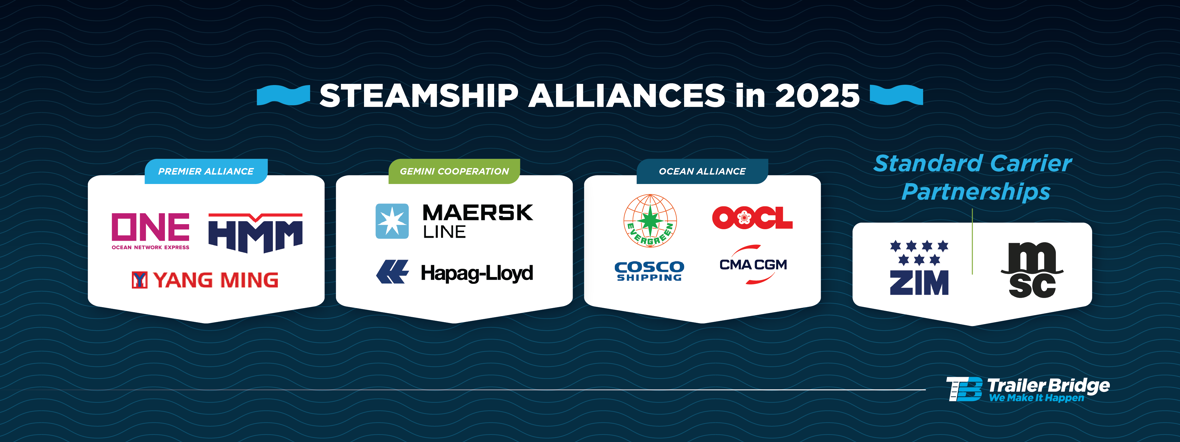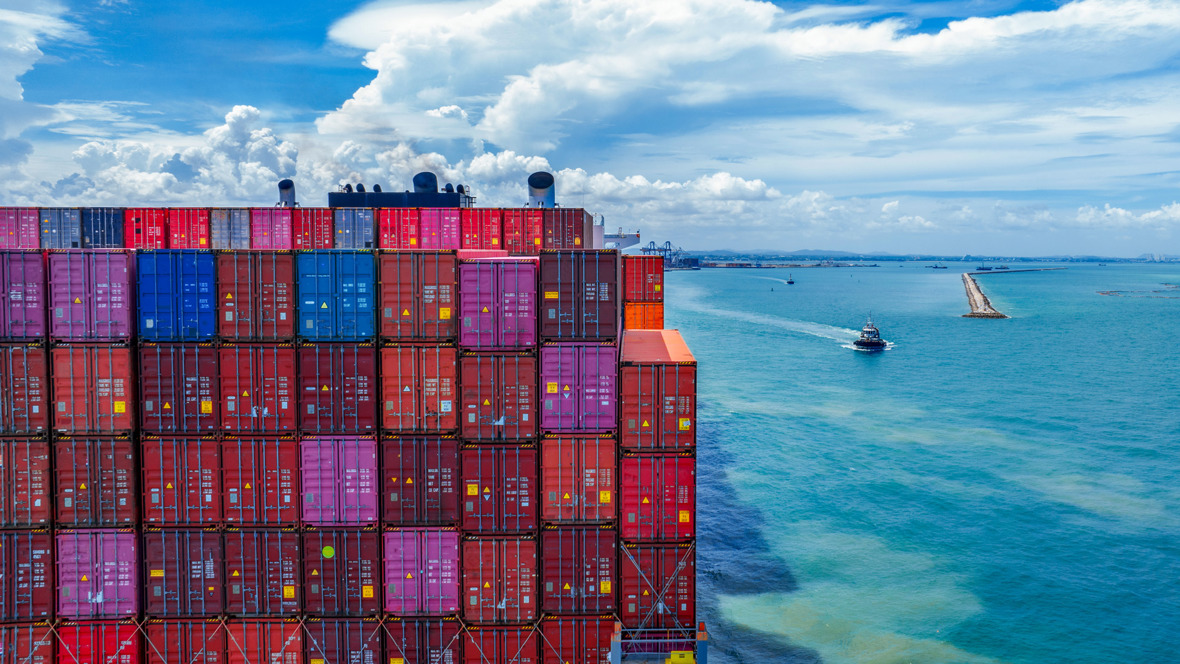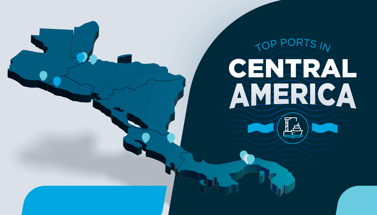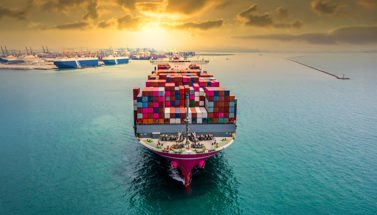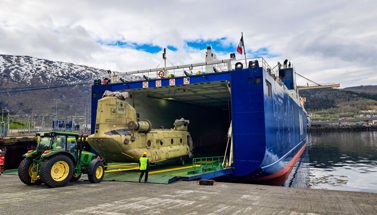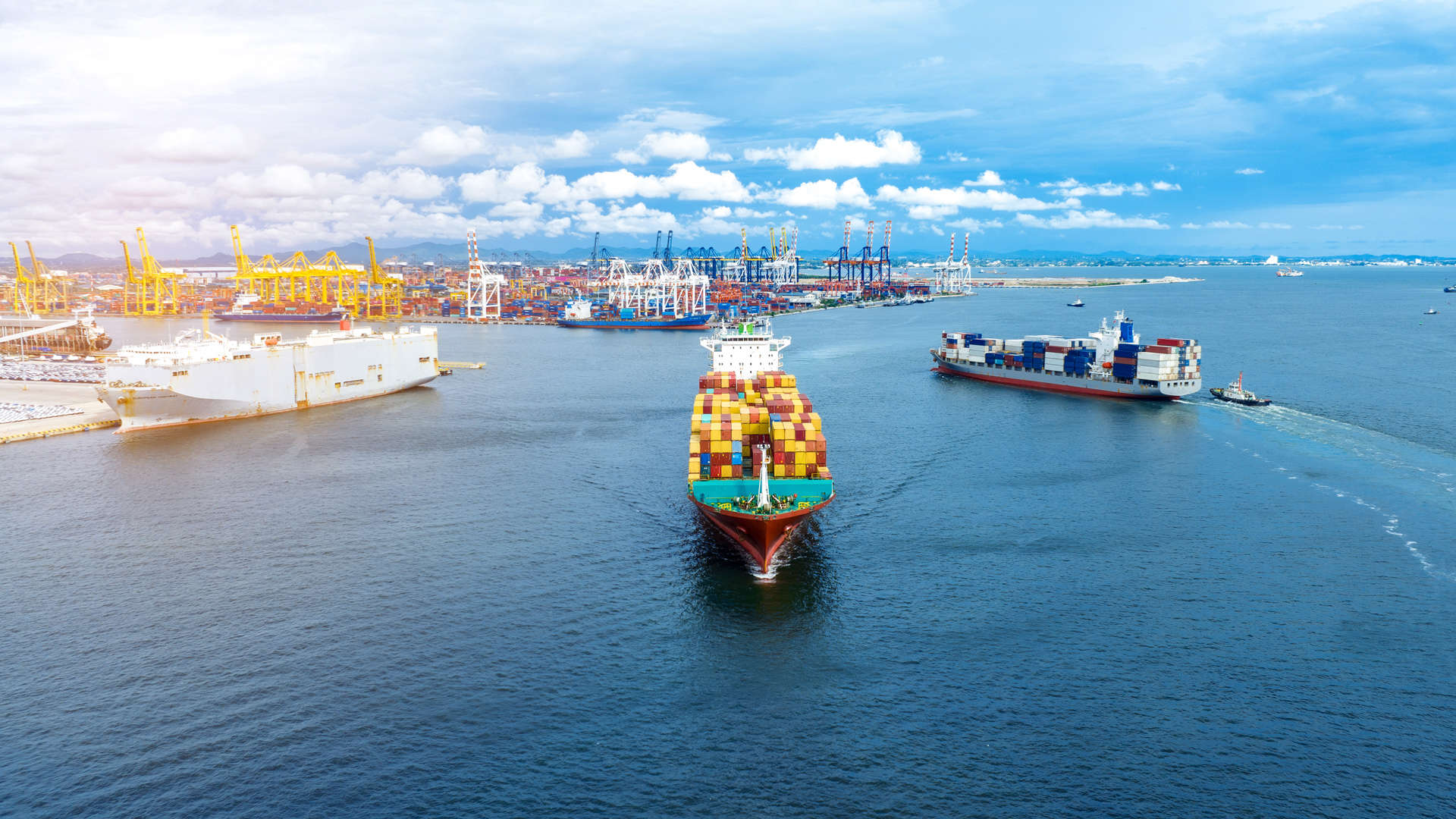
Your Guide to Steamship Alliances
Whether you’re contracting with ocean carriers directly or work with freight forwarders you need to get onboard with the recent changes to steamship alliances. New opportunities have been created and relied-upon services are shifting. Understanding the ramifications of the new vessel sharing and slotting arrangements is one thing—leveraging their advantages amidst the rolling seas of disruptions today is another thing altogether.
Here’s everything you need to know from a global trade expert whose job it is to leverage the strengths of the steamship alliances through seasonality, port strike or tariff threat, Trailer Bridge’s own Zach Monger, Director, NVOCC & Compliance.
Overview and Insights into the Changes
2M Alliance of MSC and Maersk Ends
MSC has gone off on its own and Maersk has joined Hapag-Lloyd in the new Gemini Cooperation. It’s the end of a 10-year vessel sharing agreement (VSA) that started in 2015. The shift highlights the relentless growth of the Mediterranean Shipping Co. (MSC) fleet and all-in strategic commitment to leading the industry in fleet expansion and direct port connections.
Gemini Cooperation of Maersk and Hapag-Lloyd Begins
Maersk and Hapag-Lloyd have joined forces with the aim of achieving 90% on-time service reliability. The average schedule reliability for ocean container shipping was 52.8% in 2024, according to Sea-Intelligence. “Maersk and Hapag are going more towards a premium service,” Zach says. “Not the norm at all in the market, but if they can hit that number and retailers or other large shippers start understanding that it’s working, they'll will most likely pay the premium price for it.”
MSC Decides to Go It Alone
MSC has officially gone solo with its departure from the 2M Alliance. “Their strategy has been purchasing any available ships on the market,” Zach points out. “They’re at 801 ships right now with 420 vessels purchased since 2020.” He says their strategy is to be able to offer direct port pairings. “I’ve read their goal is to have 1900 direct port pairings.” Zach adds that with direct port pairings there is no transshipment which has the potential to eliminate a main cause of cargo delays.
Premier Alliance Brings Together ONE, HMM, and Yang Ming
In its prior incarnation as THE Alliance, this was the biggest alliance. With Hapag-Lloyd’s departure for the Gemini Cooperation, THE Alliance is now known as the Premier Alliance. It still has three of the world’s top ten carriers. Zach says their strength lies in the transpacific and Asia-Europe trade lanes. “If you need a well-established Asia to Europe service, the Premier Alliance is strong in that particular region.” ONE (Ocean Network Express) is an alliance within an alliance, integrating the Japan-based trio Kawasaki Kisen Kaisha (K-Line), Mitsui O.S.K. Lines (MOL) and Nippon Yusen Kaisha (NYK).
Continuation of the Ocean Alliance CMA CGM, COSCO Shipping, Evergreen, and OOCL
The Ocean Alliance of CMA-CGM, COSCO Shipping, Evergreen, and OOCL remains unchanged. With four of the top ten carriers in the world, Zach says the Ocean Alliance is a leader in the lanes between Asia and both the East and West Coasts of North America as well as the transpacific lanes. The strengths of the four combine for a powerhouse network. CMA CGM is the 3rd largest shipping line in the world. Chinese-owned COSCO is China’s largest shipping line and the world’s 4th largest. OOCL has a notable presence in the Gulf and Evergreen leads the industry in sustainability. According to Freightwaves, the Ocean Alliance has extended its cooperation agreement until 2032. This stability ensures consistent service offerings across key global routes.
What do these Steamship Alliances Mean for Shippers?
In a broad sense, alliances are meant to bring greater efficiency and more reliability to ocean container shipping worldwide. The moves also offer the possibility of more competitive pricing for ocean transportation.
Zach explains that steamship lines began creating alliances to gain competitive advantage. “The alliances were formed mainly to offer services throughout the globe without requiring lines to have their own assets in a particular trade. They focus on alignment within the alliance and vessel share allowing their shippers to come to one carrier or the other for whatever need they have.”
He adds, “The main focus is to offer more of a global solution versus very specific port pairings or just what they're good at.” From a shipper’s perspective, you’re dealing with one entity, your carrier, and everything goes through them.
Although the alliance changes take place behind the scenes, they can have a big impact, opening new possibilities and potentially changing schedules and transit times that may disrupt standards you’re used to. We’re still in the early stages of the new alliances. Zach warns shippers to be aware there could be continuous adjustments and changes in the near future.
Here’s what shippers can expect:
Expanded Routing Options
The restructuring introduces new service offerings and routing options that enhance shippers’ flexibility. For example, MSC's standalone East-West solutions feature five trades with 34 loops that include routing options via both the Suez Canal and the Cape of Good Hope, according to Maritime Executive.
One intended benefit of carriers is to provide seamless service they couldn’t offer by themselves. With better coverage and more resources at their disposal, carriers can arrange routes without transshipments—or with transshipments between alliance partners that are expected to streamline the shipping process. This is also enhanced by advanced technology such as cargo being managed within one system.Enhanced Service Reliability
Another intended benefit of carriers is to improve reliability. The alliances provide more routes and robust schedules for customers. The additional capacity is an added value that helps make shippers’ supply chains more predictable.Potential for Competitive Pricing
The increased competition resulting from these new alliances may lead to more competitive pricing and diversified service offerings for importers and exporters.
Zach points out that in addition to potential pricing advantages from competition among alliances there may also be efficiency improvements that lead to cost savings that get passed onto shippers, too. He says that shippers should investigate pricing variability within alliances themselves. The rate alliance members charge for the very same vessel can vary.
Alliances Add Diversification Amidst Disruption
The unavoidable question today is what the alliances mean for the ever-present risk of disruptions and the uncertainty caused by tariff threats.
A main attribute of alliances is their ability to reduce risk. Alliance partners can assist other members of their alliance by providing solutions to challenges they encounter. And they can do so seamlessly because they’re part of the same system.
In the present environment, shippers are wise not to have all their containers with one carrier or onboard one vessel or going to only one port. If there’s a delay, you could have all your cargo tied up on the same ship. The alliances comprised of multiple carriers provide a degree of diversity and built-in options to easily pivot to other services or other carriers in the alliance.
Diversification from one alliance may not be enough though. “There's a lot of mystery with these alliances and what's going to happen in the future,” said Zach. He encourages shippers to diversify their overall carrier base. “I think diversification is critical today. Shippers should look to establish strong relationships with multiple carriers and freight forwarders to protect their supply chain against the uncertainty known today as well as the unknown of tomorrow.”
It's not just having alternatives for ocean capacity, Zach says. Shippers should also consider diversity within their port options for import and export. “You may not know what port of entry is going to be your most valuable capacity port depending on the current environment. A well-thought-out contingency plan is helpful when you must quickly respond to ensure goods continue to flow to you end consumer.”
Best Practices Help Shippers Amidst Recent Changes
The actual and sustaining impacts of the alliance shifts are still a work in progress. According to the International Transport Forum, the aim of alliances is to achieve economies of scale and wider service coverage—both good things. Nevertheless, the industry requires shippers remain vigilant and flexible in planning and sustaining efficient operations.
That means monitoring the changes. Zach says, “You must keep up with it so you know what the best solution is for your supply chain. You might've been moving something with a particular carrier for years and now it’s no longer the best solution for you because that carrier may have discontinued a route or added a transshipment. There’s also the possibility your transit time will increase with the new alliances’ schedules and vessel rotations.
Finding an alternative to a steamship line that isn’t working for you is time consuming work for shippers. The research process, carrier conversations and negotiation are anything but instantaneous.
Zach stresses the importance of advanced planning and having diverse partnerships in place. “I think one of the biggest safeguards for shippers is diversification - not relying on a single alliance or a single carrier. The ability to work with multiple carriers helps you get access to the best routing and the best pricing. That’s where freight forwarders like Trailer Bridge come into play, because we already have contracts across alliances,” Zach says.
Navigate Complexity with Technology
Juggling the variables of routings, transit times, rates and availability in the context of steamship alliances is a job for technology. Leveraging the benefits and ensuring you’re maximizing the opportunities requires investigating all the variables all at once. The manual work of planning and pricing through carrier websites can take days—and by then the gameboard can change.
Zach says that technology today does the work in minutes, taking alliance permutations into account in the moment.
Trailer Bridge uses leading-edge technology to compare rates of all alliances as well as mid-tier and smaller carriers too small to participate in a major alliance. The best option available is achievable for every shipment along with mode alternatives and port options.
“If we're looking at say Savannah into Georgetown, Guyana or Shanghai to New York, we can run that lane through a software based on our contracts and it gives us rates, schedules, and transit times for each carrier. As a result, we’ll get in a few seconds what could potentially take a shipper days and weeks to find by themselves,” Zach explains
It’s a prime example of why freight forwarders provide the advantage to shippers dealing with ever-increasing complexity from alliance changes and the need to diversify.
“A strong partnership with a freight forwarder – for a small to midsize shipper, especially - offers a competitive edge and ease of doing business. They do all the work for you. They do the research. They leverage their relationships across steamship lines for the benefit of the shipper. All that paired with access to industry leading technology for planning and route optimization to drive efficiencies within your supply chain,” Zach says.
A Freight Forwarder Makes Alliances Your Ally
With the new steamship alliances there’s great potential for shippers to increase reliability and reduce rates. The catch is that contracts still dictate where many benefits are attainable.
Freight forwarders who have bargaining power to negotiate rates and secure capacity have the clout that small to midsize shippers – and even some larger shippers - lack to make the most of alliance advantages.
Combined with relationships that personalize your service and technology that synthesize numerous and ever-changing variables, a freight forwarders’ experience and pulse on the industry helps shippers maximize alliance advantages.
